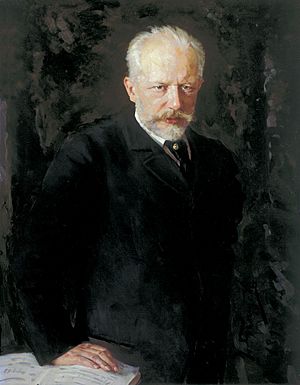1812 Overture facts for kids
The 1812 Overture (French: Ouverture solennelle "L'Année 1812"; Russian: Торжественная увертюра 1812 года, Toržestvennaja uvertjura 1812 goda) (Op. 49) is an orchestral work by Pyotr Ilyich Tchaikovsky. It commemorates Russia's 1812 defense against Napoleon's advancing Grande Armée at the Battle of Borodino, during the French invasion of Russia.
The Overture's first public performance occurred on 20 August 1882 (NS; the OS date was 8 August). The venue was the Cathedral of Christ the Saviour in Moscow. The overture is best known for its climactic volley of cannon fire and ringing chimes.
Instrumentation
The 1812 Overture is written for an orchestra which uses following music instruments:
- Heavy Artillery
- Cannons
Musical structure
Sixteen cannon shots are written into the score of the Overture. The Overture begins with the plaintive Russian Orthodox Troparion of the Holy Cross ("God Preserve Thy People") played by eight cellos and four violas. The piece moves through a mixture of pastoral and militant themes. The Overture includes the Russian folk dance "At the Gate, at my Gate." At the turning point of the invasion – the Battle of Borodino – the score calls for five Russian cannon shots. A descending string passage represents the following retreat of the French forces, followed by victory bells and a triumphant repetition of God Preserve Thy People as Moscow burns to deny winter quarters to the French. A musical chase scene appears. Out of it, the anthem "God Save the Tsar!" appears. The overture uses counterpoint to reinforce the appearance of the leitmotif that represents the Russian forces throughout the song.
Although God Save The Tsar! was the Russian National Anthem in Tchaikovsky's time. It was not the anthem in 1812. There was no official Russian anthem until 1815.
There are several recordings of the overture in a transcription by American conductor Igor Buketoff, with the following changes and additions:
- The opening segment, "God Preserve Thy People" is sung a cappella by a choir.
- A children's or women's choir added to the flute and cor anglais duet rendition of "At the Gate".
- The orchestra and chorus unite in the climax with a triumphant version of "God Preserve Thy People" and "God Save the Tsar".
Images for kids
See also
 In Spanish: Obertura 1812 para niños
In Spanish: Obertura 1812 para niños



